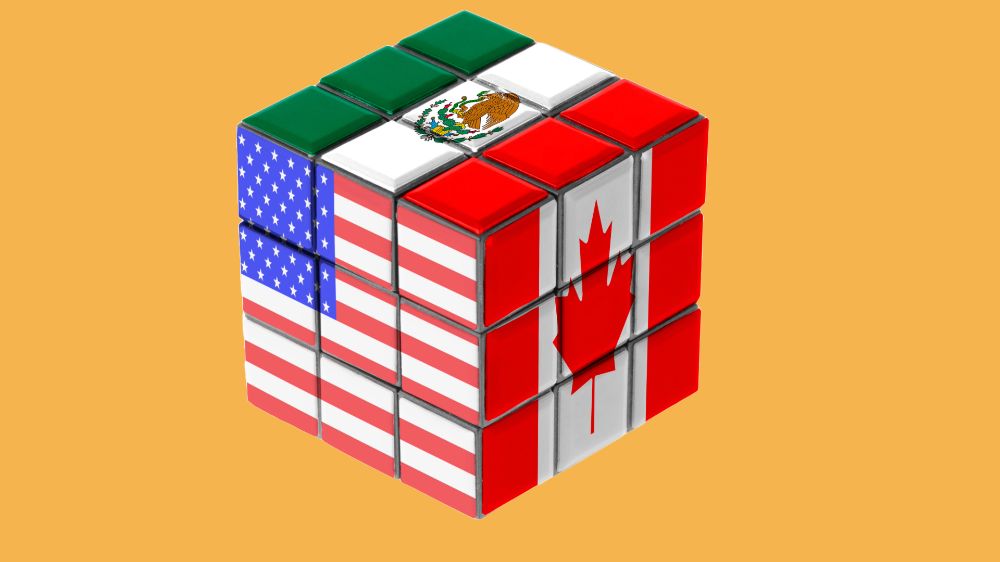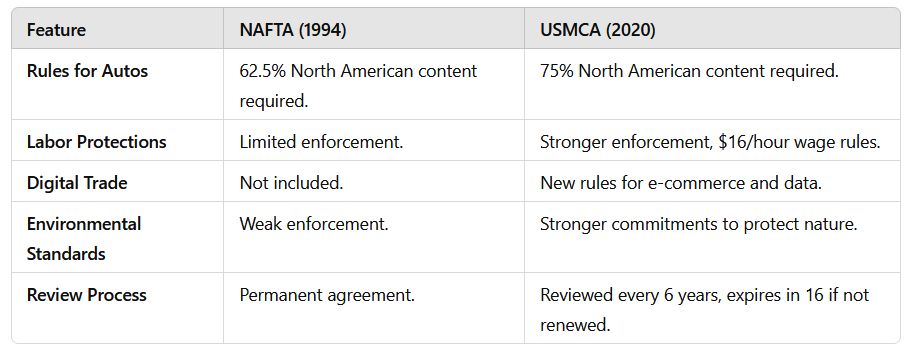What Is the United States-Mexico-Canada Agreement (Usmca)?

The United States-Mexico-Canada Agreement (USMCA) is a trade deal between the United States, Mexico, and Canada. It replaced the older North American Free Trade Agreement (NAFTA) on July 1, 2020. While USMCA builds on many of the ideas from NAFTA, it introduced some important updates to address modern challenges in trade and business.
Why Was USMCA Created?
NAFTA, which started in 1994, was one of the most significant trade agreements of its time. It removed many barriers to trade among the three countries and boosted economic cooperation. However, by the 2010s, NAFTA began to face criticism for a few reasons:
- Changing Economies:
The economy had changed a lot since the 1990s. New industries like technology and e-commerce were becoming more important, and NAFTA didn’t address them. - Job Loss Concerns:
Critics, especially in the United States, said NAFTA caused some U.S. manufacturing jobs to move to Mexico, where wages were lower. - Unfair Trade Practices:
Some argued that NAFTA didn’t do enough to ensure fair competition among the three countries, especially when it came to wages and labor rights. - Political Pressure:
In 2016, U.S. presidential candidate Donald Trump made renegotiating NAFTA a key part of his campaign. After being elected, he pushed for changes to the agreement, saying it needed to be modernized to better protect American workers and businesses.
How Was USMCA Negotiated?
The process of replacing NAFTA with the USMCA took about two years of negotiations:
- Start of Talks (2017):
The U.S., Canada, and Mexico began renegotiating NAFTA in August 2017. Each country wanted to protect its industries while making the deal fairer for everyone. - Reaching an Agreement (2018):
By September 30, 2018, the three countries announced they had reached a new deal: the USMCA. It kept many elements of NAFTA but introduced significant updates. - Final Approval (2020):
The USMCA was officially approved by all three countries and went into effect on July 1, 2020.
Key Features of the USMCA
The USMCA updated several parts of NAFTA to address modern issues and concerns. Here are the most important features:
1. Autos and Manufacturing
The USMCA includes new rules for making cars and trucks:
- More North American Content: To avoid tariffs, 75% of a vehicle’s parts must come from North America (up from 62.5% under NAFTA).
- Higher Wages: By 2023, at least 40-45% of the work on a vehicle must be done by workers earning at least $16 per hour. This helps protect higher-paying manufacturing jobs, especially in the U.S. and Canada.
2. Labor Rights
The USMCA strengthened protections for workers in all three countries:
- Mexico agreed to improve workers' rights, including allowing workers to form unions and negotiate better wages.
- New enforcement tools were introduced to ensure that labor standards are followed.
3. Dairy and Agriculture
The USMCA made significant changes for farmers:
- Access to Canada’s Dairy Market: U.S. farmers gained more access to sell milk, cheese, and other dairy products in Canada.
- Protection for Canadian Farmers: Canada kept its "supply management" system, which controls the production of certain dairy products to keep prices stable.
4. E-Commerce and Digital Trade
Since NAFTA didn’t address digital trade (like online shopping or cloud computing), the USMCA added new rules:
- No tariffs on digital products like e-books, music, and software.
- Strong protections for intellectual property, including patents, trademarks, and copyrights.
- Rules to prevent countries from forcing companies to store data only within their borders.
5. Environmental Protections
The USMCA includes commitments to protect the environment:
- New rules to reduce pollution and protect marine life.
- Promises from all three countries to enforce their environmental laws.
6. Dispute Resolution
The USMCA kept a system to resolve trade disputes between the three countries, ensuring businesses and governments have a fair way to address disagreements.
7. Sunset Clause
The agreement includes a "sunset clause," meaning it will be reviewed every six years. If all three countries agree, it will continue for another 16 years. This ensures the agreement stays relevant and can be updated as needed.
Benefits of the USMCA
Here’s how the USMCA benefits each country:
For the United States
- Protects high-paying manufacturing jobs with rules on wages and North American-made parts.
- Expands access for American farmers to sell dairy and agricultural products in Canada and Mexico.
- Boosts digital trade, which is a growing part of the U.S. economy.
For Canada
- Preserves its strong trade relationship with the U.S., its largest trading partner.
- Protects key industries like dairy farming.
- Ensures fair labor and environmental standards across North America.
For Mexico
- Helps attract foreign investment, especially in manufacturing.
- Improves wages and rights for Mexican workers.
- Strengthens trade ties with the U.S. and Canada, which are vital for Mexico’s economy.
How USMCA Is Different from NAFTA
Here’s a quick comparison of key differences between the two agreements:

PDF of The 67 American Products to Boycott If Tariffs Against Canada Are Implemented
How to Boycott 67 US Products to Combat Tariffs Against Canada
How To Replace 67 American Products You Use With Canadian Products

